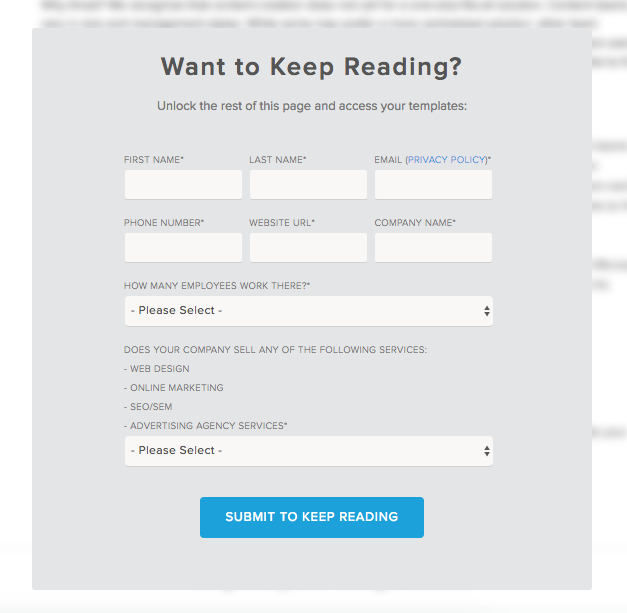If you're just tuning in, allow me to catch you up: This post is the second in a two-part series on our experiment to move gated offer content onto a site page, and test different conversion methods. Back in Part I, we saw significant increases in organic search traffic only on offers that already were performing well for search. Let's walk through what we did for Part II of our CRO Test, followed by the results of both tests. The Hypothesis and Objective In Part I, we hypothesized that by partially gating the content on our newly-created HTML offer pages, we could provide a better user experience and still generate leads from it. The Experiment With conversion rates way down on our previous CRO tests, we thought to ourselves, "If we want to get our conversion rates back to their original levels, let's make the landing page look like it usually does, but with the organic gains of having the offer content on the page itself." Can Google crawl and index that hidden content?” The answer is a resounding, “Yes.” While that HTML content exists behind a CSS layer initially blocked by the template, it turns out that Google is still able to successfully crawl and index it. Plus, if you can increase organic traffic significantly to the landing page, while also retaining the high conversion rates of the original landing page design -- jackpot. By lifting conversions to their original rates -- or better -- while simultaneously getting that boost in organic traffic from the crawlable offer content, both offers achieved significant increases in net organic submissions and contacts. However, content can still be gated in a way that provides a better user experience, which was part of the impetus behind this experiment. Next Steps and Recommendations In Part I, we learned -- much to our chagrin -- that we could increase organic traffic by putting offer content onto an HTML site page only for offers that were already receiving strong search traffic.

Welcome back. If you’re just tuning in, allow me to catch you up: This post is the second in a two-part series on our experiment to move gated offer content onto a site page, and test different conversion methods. If you missed Part I, check it out here.
Back in Part I, we saw significant increases in organic search traffic only on offers that already were performing well for search. Also, our Conversion Rate Optimization (CRO) test failed. So in Part II, we turned our focus to running more CRO tests.
In order to avoid putting many more conversions at risk, we decided to test the offers we’d already experimented with to find a conversion method that worked well. We tested two of the three offers we experimented with in Part I, but this time, our approach was a bit different.
Let’s walk through what we did for Part II of our CRO Test, followed by the results of both tests.
Does Un-gating Offers Improve Conversion Rate?
The Hypothesis and Objective
In Part I, we hypothesized that by partially gating the content on our newly-created HTML offer pages, we could provide a better user experience and still generate leads from it.


But in reality, page visitors:
- Decided the content was not valuable enough for them to exchange contact information to see the rest of it.
- Expected to be able to read the entire offer, and were put off by the experience of running into a form upon scrolling.
So, we took each of these findings and used them build two tests within Part II of the experiment, each with its own sub-hypothesis, but a shared objective: to increase net submission and contact numbers, so that they’ll surpass those of the original landing pages pointing to gated PDFs.
CRO Test #1
Hypothesis: By hiding all of the written content behind a partial gate template — with the blur effect pictured below — readers arriving at the site through search will be intrigued enough by the topic to convert on the page.
CRO Test #2
Hypothesis: By setting the expectation of a gated offer early on — by using a form that looks and reads just like our normal landing pages, but opens into an HTML page upon form submission instead of an offer download — more people will fill out the form.
The Experiment
With conversion rates way down on our previous CRO tests, we thought to ourselves, “If we want to get our conversion rates back to their original levels, let’s make the landing page look like it usually does, but with the organic gains of having the offer content on the page itself.”
So, we pitched the idea of a brand new, gated template that looks and reads just like our regular landing pages, with one key difference: When the user clicks the form submission button, the page opens into an HTML page, instead of leading to a thank-you page with a PDF download button.
My colleague, Patrick Wilver, built this template for us. Here’s a GIF of the template in action:
.gif?t=1500974980673&width=2007&name=ezgif.com-optimize%20(1).gif)
You might be wondering, “But what about SEO? Can Google crawl…

COMMENTS